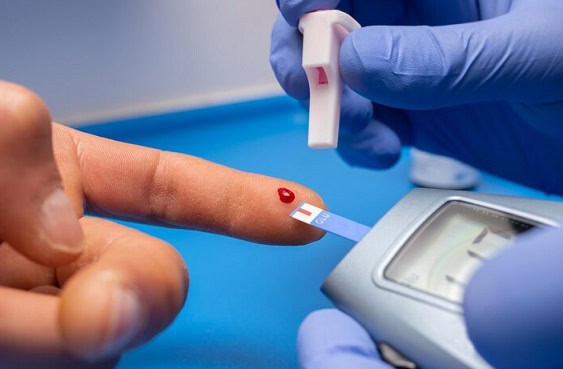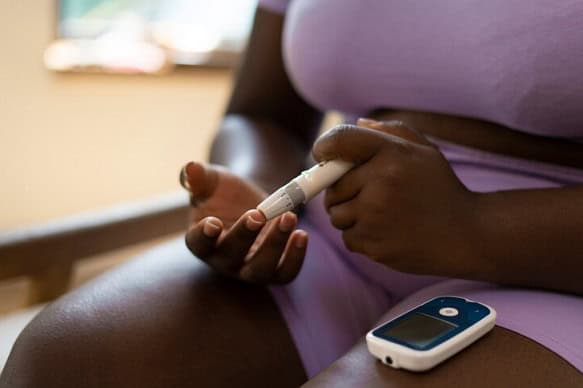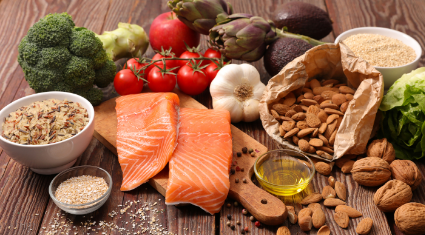9 Foods That Lower Blood Sugar Levels
10 mins,



Some foods can help one manage their blood sugar level properly. In this article, we look at the right foods that lower blood sugar levels. The plan is to provide you with healthy foods to keep your blood sugar level in moderation.

There are foods that lower the blood sugar level naturally when consumed. They are usually called low glycemic foods which means they contain little or no sugar. It is important for diabetic patients or those at risk of developing one to always watch their blood sugar level.

The major sugar found in the blood is called blood sugar or glucose. It supplies the body with energy. The blood sugar comes from the carbohydrates we eat which get broken down into glucose or sugars and released into the bloodstream.
When the body is not using glucose, it stores it in the liver and muscles as glycogen and releases it when the blood sugar level is low.
After eating the blood sugar level rises and the body signals the pancreas to release insulin. Insulin is a hormone that opens up the cells to allow the blood sugar to flow in for energy production.
Without insulin, the blood sugar level will rise above normal and result in hyperglycemia which can cause conditions like diabetes, kidney failure, blindness, poor injury healing etc.
The blood sugar level is the amount of sugar found in the blood. It needs to be regulated to maintain a balance. If the blood sugar is not regulated and the bloodstream gets overloaded, it can lead to a condition called hyperglycemia. On the other hand, if the blood sugar level is too low, it can result in a condition called hypoglycemia which can cause confusion, dizziness, liver disease, seizures etc.

According to the World Health Organization (WHO), the normal fasting blood sugar level should be between 70 mg/dL (3.9 mmol/L) and 100 mg/dL (5.6 mmol/L)
The sugar in the blood comes mostly from carbohydrate foods. High-carbohydrate foods include candy and sweets, sodas, pasta, white bread and white rice. The more carbohydrates you consume, the higher your blood sugar levels will be.

Food rich in fiber, protein and healthy fats stands a better chance of reducing blood sugar than those rich in carbohydrates. Below are health foods that have been proven to reduce one’s blood sugar level, especially in diabetic patients and those at risk.
Whole grains like brown rice, wheat, barley oats, etc contain more fiber. They also do not digest fast thereby reducing blood sugar. A study in 2018 associated the consumption of whole grains to reduce the risk of Type 2 diabetes in individuals. Consuming whole grains also helps fight obesity and insulin resistance.
Protein-rich legumes like beans, lentils and peas are rich in fiber and antioxidants and can reduce blood sugar levels. Legumes are known as low glycemic foods which means they contain little sugar. A study showed that diabetic patients who replaced red meat with legumes had reduced blood sugar levels, blood pressure, and cholesterol levels and improved cardiovascular health. Legume consumption has also been shown to reduce the risk of developing type 2 diabetes.
Leafy greens and vegetables are rich in fiber and micronutrients. Sources include cabbage, garden eggs, lettuce, celery, spinach, broccoli pumpkin, kale etc. Leafy greens contain higher fiber and may help reduce blood sugar levels.
Animal proteins such as eggs and fatty fish like salmon, mackerel, tuna, oysters, cod, and sardines are rich in antioxidants, vitamins and minerals. Consumption of these proteinous foods may help reduce blood sugar levels.
When it comes to fruits, it is best to eat whole fruits because they contain more fiber which helps slow down digestion and reduce the blood sugar level. It is also advisable to choose fruits that are low in sugar like apples, berries, citrus fruits, cucumber, watermelon, broccoli. Here is a guide on how to make healthy smoothies with fruits.
Some healthy nuts and seeds to eat include walnuts, almonds, cashews, peanuts, chia seeds, flaxseeds,etc.
Nuts and seeds contain healthy fats, vitamins and nutrients, high fiber and are low in sugar. This study in 2007 shows that eating almonds reduces blood sugar levels, cholesterol and coronary heart disease. Chia seeds on the other hand convert glucose into complex carbohydrates thereby reducing the blood sugar level as complex carbohydrates promote satiety and help with weight loss.
Healthy fats can be found in Avocado, olive oil, and almond oil. Healthy fats and oils contain antioxidants and help reduce inflammation and heart disease.
The addition of extra virgin olive oil was found to stabilize blood sugars and manage type 2 diabetes.
Fermented foods like Kimchi, kefir, soybeans, black garlic and Probiotic foods like yogurt are helpful to diabetics and those at risk of developing it because they contain bacteria that support a healthy gut. The gut bacteria plays a role in reducing the sugar level.
A meta-analysis study showed that consumption of green tea helped reduce levels of fasting insulin, fasting glucose and blood sugar levels in 17 randomized controlled trials.

The type of meal you consume will determine if your blood sugar level will increase or decrease. A meal that contains high carbohydrates will generally increase blood sugar as most sugars come from carbohydrate breakdown. A meal low in carbohydrates but contains more fiber, protein and healthy fats will help reduce the blood sugar level.
The normal blood sugar level should be less than 99 mg/dL and this is what everyone should aim for to keep an optimum blood sugar level. Diabetes and other serious consequences might result from abnormal or high blood sugar levels. The best strategy to ensure that blood sugar levels remain within a healthy range is to monitor it from time to time with some home kits for blood sugar tests.
Foods that are high in carbohydrates like white bread, pasta, white rice, soda drinks, juice etc. These are loaded with high amounts of refined sugars and cause the blood sugar level to rise.
2. How do you feel when your blood sugar is too high?
When the blood sugar is too high, It can cause hyperglycemia. These are the signs of blood sugar you should take note of:
3. How do you feel when your blood sugar is too low?
When your blood sugar drops to a reading lower than 70 mg/dL, you may develop hypoglycemia which means low blood sugar. The symptoms show quickly and the after-effects can be dangerous if not treated on time. Some of the symptoms include:
4. Can drinking water lower blood sugar?
Drinking water helps keep the body hydrated, promotes excretion, and reduces blood sugar levels and the risk of diabetes. The conclusion from a meta-analysis study in 2021 revealed that the blood sugar level and risk of type 2 diabetes was reduced in people who drank more water.
5. What should I eat if my sugar is high?
Once you notice that your blood sugar level is high, it is advisable to go to the hospital immediately and see a doctor for proper diagnosis and treatment. Then with the help of a dietician, you can plan a meal that is high in fiber, proteins, vegetables, healthy fats, nuts, seeds, fruits, and fermented foods to help reduce the blood sugar level.
6. How to control sugar without medicine?
To control blood sugar without medicine, You need to engage in regular exercise, change your diet to low-carbohydrate food, take water regularly and cut down on refined sugary drinks and foods.
Telemedicine offers the option of speaking or chatting with medical professionals online. The convenience and accessibility it offers make it your best option in today’s world where it is not easy to book a doctor’s appointment anymore.
Telemedicine makes it easier and faster to consult a doctor from the comfort of your home. With your smartphone, you can speak or chat with a doctor in a matter of seconds.
With KompleteCare, you can talk to a specialist about your general health concerns, prescriptions, health counseling etc.
If you have any concerns or questions about foods to lower blood sugar, do not hesitate to talk to our doctors who are working 24/7 to make sure you are well-attended to.
References
American Diabetes Association. (2024 ). Hyperglycaemia (High blood glucose)
NHS. UK. (2024). Hypoglycemia ( Low blood sugar)
World Health Organization (WHO). Mean fasting blood glucose.
National Library of Medicine. (2020). Low-Carbohydrate Diets in the Management of Obesity and Type 2 Diabetes: A Review from Clinicians Using the Approach in Practice
National Library of Medicine. (2018). Wholegrain Intake and Risk of Type 2 Diabetes: Evidence from Epidemiological and Intervention Studies
European Journal of Clinical Nutrition. (2014). Substitution of red meat with legumes in the therapeutic lifestyle change diet based on dietary advice improves cardiometabolic risk factors in overweight type 2 diabetes patients: a cross-over randomized clinical trial
National Library of Medicine. (2018). Legume consumption is inversely associated with type 2 diabetes incidence in adults: A prospective assessment from the PREDIMED study
Andreaal.et alz. (2007). Almonds and postprandial glycemia–a dose-response study
Celine et al. (2019). Impact of Gut Microbiota on Host Glycemic Control.
Kai Liu et al. (2013). Effect of green tea on glucose control and insulin sensitivity: a meta-analysis of 17 randomized controlled trials
Shirin et al. (2018). Egg consumption may improve factors associated with glycemic control and insulin sensitivity in adults with pre- and type II diabetes
Nasim et al. (2021). Water intake and risk of type 2 diabetes: A systematic review and meta-analysis of observational studies

Chioma Okwara is an Anatomist and a health content writer. She specializes in topics related to public health, mental health and infertility. Chioma is a Volunteer for Whispering Hope Africa Initiative ( WHAiafrica) where she offers her services to helping the poor in the rural areas of the Nigeria.
We publish helpful posts every week!